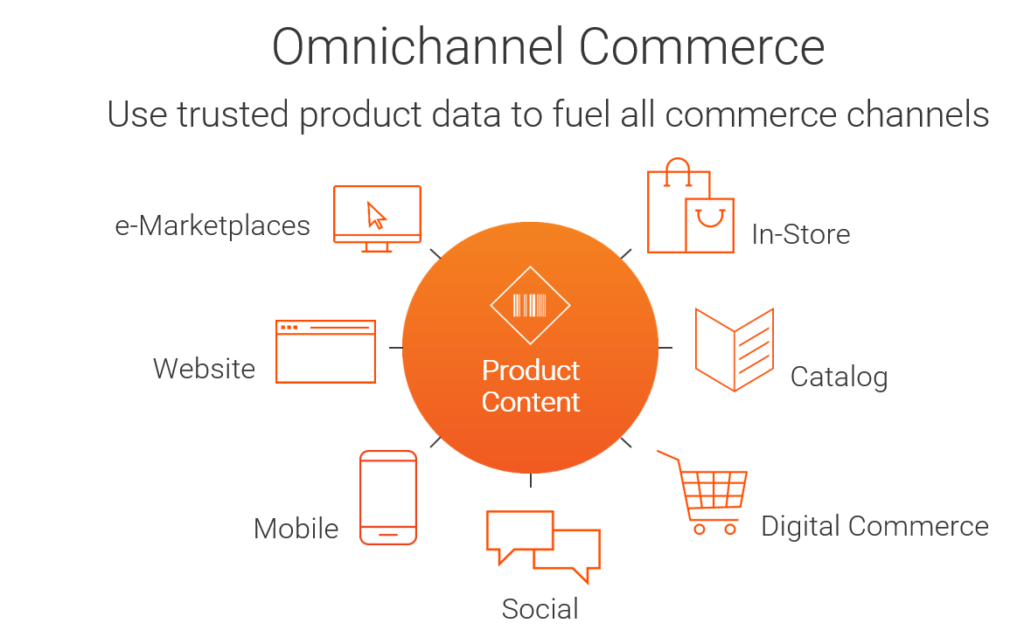An Omnichannel Commerce Approach: What You Should Know

Omnichannel commerce was a consistent trend in 2019 and will continue to be a major aspect of customer experience (CX) strategy for brands and retailers in 2020. According to a Google report, 83% of U.S. shoppers who visited a store in the last week used online search before going to the store. And about 45% of global shoppers buy online and pick up in-store—a perfect example why you need a focus on omnichannel commerce. For a true omnichannel experience, you need to market products through multiple sales and marketing channels to ensure that you’re reaching your customers with a relevant message at the right time and place. Intelligently managing your customer and product data is key to making that happen.
What is Omnichannel Commerce?
Omnichannel commerce is a sales and marketing approach that provides customers with a seamless shopping experience across all touchpoints. That means they have a consistent, unified experience whether they’re shopping on your company’s website, via a marketplace like Amazon or eBay, in a store, on a social media website, through a chat bot, or in a catalog—and that experience continues if they switch channels.

With an increasing number of digital channels and touchpoints and a growing focus on customer experience, your organization needs an omnichannel strategy framework to remain in step with customers’ expectations. If you are not able to feed your commerce platforms with relevant, trusted, and complete product information and digital assets, you will miss opportunities and fall behind your competition.
Omnichannel vs. Multichannel: What’s the Difference?
Both omnichannel and multichannel commerce involve selling across different types of digital and physical channels. However, traditional multichannel approaches may separate the channels so that they do not interact and become almost like independent entities with their own stock and purchase systems—and their own customer experience.

Omnichannel commence is true to meaning of the Latin prefix “omni” in its name: it covers all channels and aims to provides a single, consistent customer experience across every interaction. While many companies are successful in selling products across one or multiple channels (multichannel commerce), omnichannel commerce requires a strategy that allows you to fuel all channels with trusted, relevant, up-to date, and complete product content to maintain a seamless customer experience.
Why do Companies Need Omnichannel Commerce? What Are the Benefits?
In the context of omnichannel commerce, the role of product information has become more important than ever. Today’s omnichannel product experience has to be customer-centric, personalized, search-guided, and social-powered. To keep up with this rapid evolution in the buying experience, make sure you’re fully leveraging product information to create a new experience that attracts and converts shoppers.
Why is this omnichannel experience important? Because multiple channels reinforce each other: a customer who doesn’t buy in one channel may well be won over in another channel based on their current interests, needs, and location.
One of the biggest challenges for most retailers is consistency of information. You may choose to share different information in each channel, but you need to provide trusted, relevant, and rich data across all digital touchpoints and channels.
The 2020 IDC PIM for Commerce MarketScape notes, “In the digital economy, both B2C and B2B customers are demanding more compelling, frictionless, and personalized commerce experiences. Retailers, manufacturers, and brands must deliver accurate product data to all their distribution channels to optimize the story being told around their products. IDC believes the importance of product information management (PIM) will only grow as organizations seek to forge stronger customer relationships within both the creation and loyalty loops via engaging product stories.”
A PIM solution provides the foundation that enables brands and retailers to collaborate and manage product content, creating a central platform to support an engaging omnichannel product experience. Learn more about PIM and product experience management (PxM) here.
What Are the Benefits of an Omnichannel Commerce Strategy?
Here are the top 3 benefits of an intelligent omnichannel commerce strategy:
- Customers get a seamless and informed buying and brand experience across all channels
- You can drive customer engagement by providing a consistent product experience in any sales or marketing channel
- You can increase conversions by meeting customers wherever and whenever they buy—and as a result, increase sales, up-sell and cross-sell opportunities
Omnichannel Commerce Trends to Watch
While omnichannel commerce used to be mainly about omnichannel consistency, in 2020 companies need to take the next step to keep up with customer expectations and an increasingly competitive marketspace. Now, they must make sure that product content is not only consistent, but also relevant, personalized, and contextual.
Adding context to omnichannel product experience
The challenge marketers face is to contextualize the omnichannel product experience. This means providing relevant product data to customers based on what you know about them or their channel activity, and what level of consent you have to use that information. This could include a consumer’s current device, purchase history, preferences, language, market segment, demographic, or location. In other words, the customer may see different products or service offers—with different levels of detail—depending on what you know about them.
The global outbreak of the coronavirus COVID-19 is already having a significant impact on how and what we buy. This includes our shopping behavior, buying preferences, and priorities. More people are now shopping online, following public health guidance to minimize human contact and reduce the risk of infection in public places. This is especially true for many in-demand consumer packaged goods (CPG) and pharmaceutical products, adding to the strain for most online grocery channels.
Retailers and brands that have a omnichannel strategy in place are better positioned to respond to rapidly changing consumer behavior. Instead of manually reacting and reconciling to manage product content, they will be able to focus on what matters most and provide a trusted, informed, and rich product experience to their customers and consumers.
Delivering relevant, personalized offers and recommendations with an omnichannel commerce approach
A 360 view of your customers and products is the foundation for customer segmentation and personalized product offerings. Digital marketing and e-commerce can create immense value by matching product information with individual customer insights and analyzing business-critical relationships. Informatica’s omnichannel commerce solution incorporates Master Data Management and Data Quality to fuel your sales channels with trusted product data and build a 360-degree view of your suppliers, products, and customers. Our approach streamlines workflows and collaboration with role- and task-based centralized access to relevant content. As a result, all departments, regions, and stakeholders can more effectively manage and collaborate on rich product content for an informed and engaging omnichannel experience.
Want to learn more about omnichannel commerce platforms and product information management? Check out the IDC MarketScape: Worldwide Product Information Management Applications.
Want to learn more about digital commerce platforms and supplier relationship management? Then register for our on demand Digital Commerce and Supply Chain Summit.








